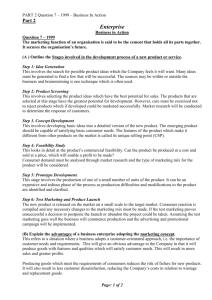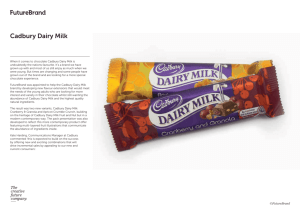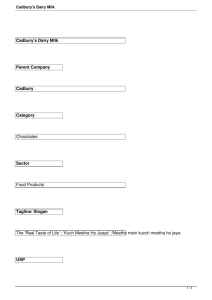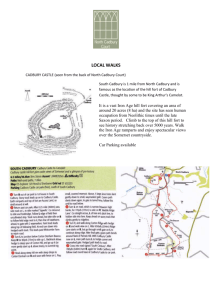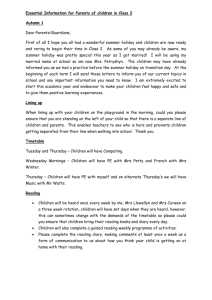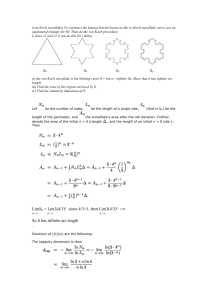using market research to launch a new brand
advertisement
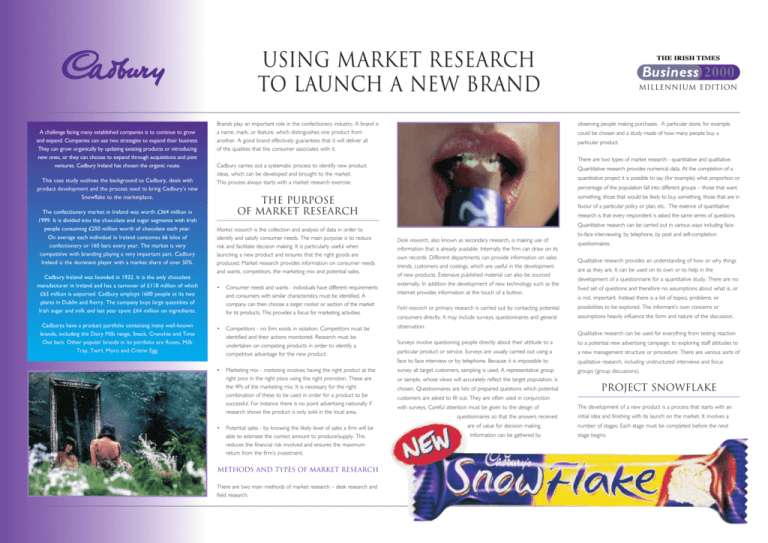
USING MARKET RESEARCH
TO LAUNCH A NEW BRAND
A challenge facing many established companies is to continue to grow
and expand. Companies can use two strategies to expand their business.
They can grow organically by updating existing products or introducing
new ones, or they can choose to expand through acquisitions and joint
ventures. Cadbury Ireland has chosen the organic route.
This case study outlines the background to Cadbury, deals with
product development and the process used to bring Cadbury’s new
Snowflake to the marketplace.
The confectionery market in Ireland was worth £364 million in
1999. It is divided into the chocolate and sugar segments with Irish
people consuming £250 million worth of chocolate each year.
On average each individual in Ireland consumes 66 kilos of
confectionery or 160 bars every year. The market is very
competitive with branding playing a very important part. Cadbury
Ireland is the dominant player with a market share of over 50%.
Cadbury Ireland was founded in 1932. It is the only chocolate
manufacturer in Ireland and has a turnover of £118 million of which
£63 million is exported. Cadbury employs 1600 people at its two
plants in Dublin and Kerry. The company buys large quantities of
Irish sugar and milk and last year spent £64 million on ingredients.
Cadburys have a product portfolio containing many well-known
brands, including the Dairy Milk range, Snack, Crunchie and Time
Out bars. Other popular brands in its portfolio are Roses, Milk
Tray, Twirl, Moro and Crème Egg.
Brands play an important role in the confectionery industry. A brand is
a name, mark, or feature, which distinguishes one product from
another. A good brand effectively guarantees that it will deliver all
of the qualities that the consumer associates with it.
Business 2000
millennium edition
observing people making purchases. A particular store, for example,
could be chosen and a study made of how many people buy a
particular product.
There are two types of market research - quantitative and qualitative.
Cadbury carries out a systematic process to identify new product
ideas, which can be developed and brought to the market.
This process always starts with a market research exercise.
Quantitative research provides numerical data. At the completion of a
quantitative project it is possible to say (for example) what proportion or
percentage of the population fall into different groups – those that want
something, those that would be likely to buy something, those that are in
THE PURPOSE
OF MARKET RESEARCH
Market research is the collection and analysis of data in order to
identify and satisfy consumer needs. The main purpose is to reduce
risk and facilitate decision making. It is particularly useful when
launching a new product and ensures that the right goods are
produced. Market research provides information on consumer needs
and wants, competitors, the marketing mix and potential sales.
•
•
•
•
Consumer needs and wants - individuals have different requirements
and consumers with similar characteristics must be identified. A
company can then choose a target market or section of the market
for its products. This provides a focus for marketing activities.
Competitors - no firm exists in isolation. Competitors must be
identified and their actions monitored. Research must be
undertaken on competing products in order to identify a
competitive advantage for the new product.
Marketing mix - marketing involves having the right product at the
right price in the right place using the right promotion. These are
the 4Ps of the marketing mix. It is necessary for the right
combination of these to be used in order for a product to be
successful. For instance there is no point advertising nationally if
research shows the product is only sold in the local area.
Potential sales - by knowing the likely level of sales a firm will be
able to estimate the correct amount to produce/supply. This
reduces the financial risk involved and ensures the maximum
return from the firm’s investment.
Methods and types of market research
There are two main methods of market research – desk research and
field research.
favour of a particular policy or plan, etc. The essence of quantitative
research is that every respondent is asked the same series of questions.
Quantitative research can be carried out in various ways including faceto-face interviewing, by telephone, by post and self-completion
Desk research, also known as secondary research, is making use of
information that is already available. Internally the firm can draw on its
own records. Different departments can provide information on sales
trends, customers and costings, which are useful in the development
of new products. Extensive published material can also be sourced
externally. In addition the development of new technology such as the
internet provides information at the touch of a button.
questionnaires.
Qualitative research provides an understanding of how or why things
are as they are. It can be used on its own or to help in the
development of a questionnaire for a quantitative study. There are no
fixed set of questions and therefore no assumptions about what is, or
is not, important. Instead there is a list of topics, problems, or
Field research or primary research is carried out by contacting potential
possibilities to be explored. The informant’s own concerns or
consumers directly. It may include surveys, questionnaires and general
assumptions heavily influence the form and nature of the discussion.
observation.
Qualitative research can be used for everything from testing reaction
Surveys involve questioning people directly about their attitude to a
to a potential new advertising campaign, to exploring staff attitudes to
particular product or service. Surveys are usually carried out using a
a new management structure or procedure. There are various sorts of
face to face interview or by telephone. Because it is impossible to
qualitative research, including unstructured interviews and focus
survey all target customers, sampling is used. A representative group
groups (group discussions).
or sample, whose views will accurately reflect the target population, is
chosen. Questionnaires are lists of prepared questions which potential
PROJECT SNOWFLAKE
customers are asked to fill out. They are often used in conjunction
with surveys. Careful attention must be given to the design of
questionnaires so that the answers received
are of value for decision making.
Information can be gathered by
The development of a new product is a process that starts with an
initial idea and finishing with its launch on the market. It involves a
number of stages. Each stage must be completed before the next
stage begins.
Product
development process
}
idea generation
ideas for a new product are thought up
product screening
the ideas are assessed and the
most promising one selected
qualitative
research
focus
groups
concept development
the idea is turned into a finished product
prototype development
a model of the product is made
{
quantitative
research
focus
groups
feasibility study
the product is assessed to
determine if it is viable
test marketing
market research is carried out to
determine consumer reaction
launch
the product is introduced to the market
Generating the idea
The search for new products is ongoing at Cadbury. This work starts with
the Cadbury Research and Development team who are continually on the
lookout for new ideas that can be developed into a profitable product.
Ideas may come from the company’s personnel or the consumer.
Brainstorming sessions are used where a group of people come
together to generate ideas. They are given complete freedom to come
up with any ideas they think might be suitable for a product. All ideas
no matter how far-fetched are submitted for discussion. The other
members then develop or improve on them.
•
•
be similar enough to the existing Flake so that consumers would
identify with it
have innovative features to attract new consumers and not impinge
on sales of the existing bar.
Researchers tried out the general idea on consumers using descriptions
or mock-ups of the product. Opinions on the concept were sought
and taken into account by the design team. From this the design team
began designing the product.
Testing the feasibility of the product
This aims to find out whether a new product idea is viable. It involves
finding out if it can be produced profitably. A detailed cost analysis
indicated that the cost of production would be similar to the existing
Flake bar. Various price assumptions were assessed until the optimum
price was decided upon and the potential profits were calculated. The
study found that the product was likely to be profitable.
Snowflake prototype
A prototype is the first working model or sample of the product.
A decision had to be made on the composition of the new bar. Many
different recipes were tried out for the new bar using different crumbly
effects, types of chocolate, and various ingredients. Two recipes of
Snowflake were developed. A milk chocolate coated flake bar and a
white chocolate coated one.
The new product also required a name. Six possible names were
selected. Research was carried out among consumers to identify the
most popular one. The results were as follows:
FAVOURITE NAME
Name
Snowflake
Whirl
Snow Swirl
Snow Twirl
Marble Twirl
White Twirl
%Choosing as First Choice
58
11
10
8
7
6
Clearly Snowflake was the most popular name and this was the one used.
The best ideas are chosen
In 1999 many different product proposals were evaluated. The idea for
a new Flake bar appeared the most promising. It offered the greatest
likelihood of success in the market. After examining existing brands,
management identified a possible gap in the market alongside the
existing crumbly milk chocolate Flake bar.
The standard Flake is one of Cadbury’s strong sellers and is readily
identifiable by consumers. To build on the goodwill of the Flake name
it was decided to introduce a related product. Other product ideas
were eliminated at this stage.
Turning the idea into a finished product
The idea now had to be turned into a marketable product. Cadbury’s
engineers were given the task of coming up with a product that would:
Following on from this the wrapper was designed. The packaging of
Cadbury products is a powerful marketing tool. While each product
has its own distinctive design it must still be obvious that it belongs to
the Cadbury range. The eye-catching wrapper of Snowflake carries the
distinctive Cadbury logo and the integration of the colour purple,
synonymous with the best tasting chocolate from Cadbury. It also
includes information on ingredients and weights as required by law.
Test Marketing the Snowflake
Test marketing is the process of finding out consumer reaction to a
product before full production commences. The final decision to invest
in a production system is only made after this is carried out. It reduces
the risk of making a costly mistake.
If a firm does not wish to carry out the research themselves they can
employ the services of a Market Research Agency. Agencies are
expensive to use but the accuracy of their work can be of great
benefit. They are experts in research and have experience of doing
similar work for other firms. Good trust must exist between the firm
and agency because of the confidential nature of the work.
A research agency was employed in the Snowflake project. Cadbury
required it to:
• judge consumer reaction to the product
• estimate potential sales
• determine the effect the new product would have on existing
Flake sales
• analyse which Snowflake option would be the optimum.
Price - pricing is vital to the success of a product. It must be
competitive, cover costs and offer consumers value for money.
Research indicated that the product should be priced at the 45p mark.
Promotion - an extensive advertising plan was put in place. Snowflake
was advertised in trade magazines, consumer magazines and other
printed media. Television, cinema and outdoor advertising was also
used. Cadbury are the sponsors of Coronation Street and Snowflake
advertisements were placed around its screening.
Place - this is the distribution channel used to get goods to customers.
It must be in place before a product is launched. Cadbury’s already had
an extensive network of wholesaler and retailers. These provided a
distribution system for Snowflake.
With all elements in place Snowflake was launched in September 2000.
A sample survey using interviews was carried out. A total of 480
people were asked to sample three products in different locations.
All respondents ate chocolate bars at least once a fortnight. Three
products were included in the test:
• a standard Flake.
• a Snowflake with white chocolate inside and milk chocolate outside.
• a Snowflake with white chocolate outside and milk chocolate
inside.
New product development is both a lengthy and expensive process. It
always contains an element of risk. However if carried out correctly
product development leads to increased sales and profits. For Cadbury
the process has resulted in a unique new product being successfully
developed and integrated into the product portfolio. Snowflake has
made a successful launch in the marketplace and will undoubtedly
contribute to Cadbury’s future success.
Tasks and Activities
The products were tested against a background of other confectionery
products. Testing was conducted in January and February 2000.
1
(a)
(b)
(c)
Explain the term Market Research.
Outline the reasons why firms carry out Market Research.
Describe briefly the role of Market Research Agencies.
2
(a)
(a)
Distinguish between Field Research and Desk Research.
Illustrate the use of the following in Primary Research:
• surveys
• questionnaires
• observation.
(a)
Describe the stages involved in the development process
of a new product.
Identify the elements of the Marketing Mix for a product
of your choice.
Results of testing
Both variations were seen to stand out well from other confectionery
products on display and the idea was generally well liked. The panel felt
that they would be interesting and unique. Snowflake rated well on:
• taste
• quality
• combination of white/milk chocolate
• balance of white/milk chocolate
• aftertaste
• overall texture
• ease of eating
• difference from other chocolate bars.
3
(b)
The white chocolate flavour inside was favoured over the milk
chocolate variety with more people agreeing this bar tasted better.
The product was seen as unique and different to the Flake. Snowflake
was seen as less of an everyday product and more special.
4
(a)
(b)
Distinguish between qualitative and quantitative research.
Describe where and why you would use each type
of research.
A considerable investment was made in new equipment and
production of Snowflake began.
5
(a)
(b)
What is a Prototype?
Describe how Cadbury’s used Test Marketing in the
development of Snowflake.
launching the Snowflake
A launch introduces a new product to the market. The timing is crucial
and all the elements of the marketing mix must be in place. These are:
Product - the product must be one that can satisfy consumer need, is
top quality and has a real point of difference. Test marketing indicated
that Sowflake met these criteria.
While every effort has been made to ensure the accuracy of information contained in this case study, no liability shall attach to either the Irish Times Ltd or Woodgrange Consultants Ltd for any errors or omissions in this case study.
Business 2000
millennium edition
